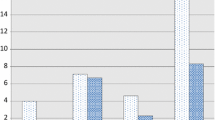Abstract
Extreme learning machine (ELM) can be considered as a black-box modeling approach that seeks a model representation extracted from the training data. In this paper, a modified ELM algorithm, called symmetric ELM (S-ELM), is proposed by incorporating a priori information of symmetry. S-ELM is realized by transforming the original activation function of hidden neurons into a symmetric one with respect to the input variables of the samples. In theory, S-ELM can approximate N arbitrary distinct samples with zero error. Simulation results show that, in the applications where there exists the prior knowledge of symmetry, S-ELM can obtain better generalization performance, faster learning speed, and more compact network architecture.









Similar content being viewed by others
References
Huang GB, Zhu QY, Siew CK (2006) Extreme learning machine: theory and applications. Neurocomputing 70:489–501
Huang GB, Zhu QY, Siew CK (2004) Extreme learning machine: a new learning scheme of feedforward neural networks. In: Proceedings of International joint conference on neural networks (IJCNN 2004), vol 2, pp 25–29
Golub G, Charles F, Loan V (1983) Matrix computations. Johns Hopkins University Press, Baltimore
Haykin S (1999) Neural networks: a comprehensive foundation. Prentice Hall, New Jersey
Cortes C, Vapnik V (1995) Support vector networks. Mach Learn 20:273–297
Minhas R, Baradarani A, Seifzadeh S, Wu QMJ (2010) Human action recognition using extreme learning machine based on visual vocabularies. Neurocomputing 73:1906–1917
Zhang R, Huang GB, Sundararajan N, Saratchandran P (2007) Multi-category classification using an extreme learning machine for microarray gene expression cancer diagnosis. IEEE/ACM Trans Comput Biol Bioinf 4:485–495
Sjöberg J, Zhang Q, Ljung L, Benveniste A, Deylon B, Glorennec P, Hjalmarsson H, Juditsky A (1995) Nonlinear black-box modelling in system identification: a unified overview. Automatica 31:1691–1724
Huang GB, Chen L, Siew CK (2006) Universal approximation using incremental constructive feedforward networks with random hidden nodes. IEEE Trans Neural Netw 17:879–892
Aguirre L, Lopes R, Amaral G, Letellier C (2004) Constraining the topology of neural networks to ensure dynamics with symmetry properties. Phys Rev E 69:1–11
Chen S, Wolfgang A, Harris C, Hanzo L (2008) Symmetric RBF classifier for nonlinear detection in multiple-antenna-aided systems. IEEE Trans Neural Netw 19:737–745
Chen S, Hong X, Harris C (2011) Grey-box radial basis function modelling. Neurocomputing 74:1564–1571
Espinoza M, Suykens J, Moor B (2005) Imposing symmetry in least squares support vector machines regression. In: Proceedings of the 44th IEEE conference on decision and control (CDC 2005), pp 5716–5721
McNames J, Suykens JAK, Vandewalle J (1999) Winning entry of the K. U. Leuven time series prediction competition. Int J Bifurcat Chaos 9:1485–1500
Huang GB, Babri H (1998) Upper bounds on the number of hidden neurons in feedforward networks with arbitrary bounded nonlinear activation functions. IEEE Trans Neural Netw 9:224–229
Wang D, Huang GB (2005) Protein sequence classification using extreme learning machine. In: Proceedings of International joint conference on neural networks (IJCNN 2005), pp 1406–1411
Suykens JAK, Vandewalle J (2000) The K. U. Leuven competition data: a challenge for advanced neural network techniques. In: Proceedings of the European symposium on artificial neural networks (ESANN 2000), pp 299–304
Acknowledgments
This work was supported by the National High-Technologies Research and Development Program of China (2006AA04Z184), the National Natural Science Foundation of China under Grant No. 10901139, 60911130510, 60874029, and the Public Benefit Technologies R & D Program of Science and Technology Department of Zhejiang Province under Grant No. 2011C21020.
Author information
Authors and Affiliations
Corresponding author
Rights and permissions
About this article
Cite this article
Liu, X., Li, P. & Gao, C. Symmetric extreme learning machine. Neural Comput & Applic 22, 551–558 (2013). https://doi.org/10.1007/s00521-012-0859-8
Received:
Accepted:
Published:
Issue Date:
DOI: https://doi.org/10.1007/s00521-012-0859-8




